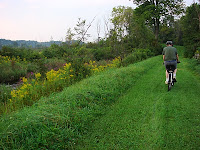I have yearned to find these falls ever since I came across them on the Black River Canal Museum site. Supposedly located 2 miles south of Boonville, Baker's Falls is created by the waste weir of lock 64 of the Black River Canal.
 Just beyond the other side of the bridge is a barely noticeable foot path. Narrow, slippery and steep at some points, the path led down to one of the most magnificent sight near the towpath.
Just beyond the other side of the bridge is a barely noticeable foot path. Narrow, slippery and steep at some points, the path led down to one of the most magnificent sight near the towpath.Baker's Falls is indeed an awesome thing to behold. It's amazing to think that this water actually had come all the way from beyond Kayuta Lake, to Forestport , the feeder canal and down the Black River Canal.
Just opposite Baker's Falls is the Lansing Kill Falls.
Water from the Black River Canal join the Lansing Kill to form a partially underground stream, eventually reaching Pixley Falls.

































